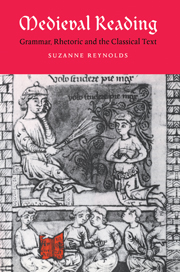Book contents
- Frontmatter
- Contents
- Acknowledgments
- Abbreviations
- 1 Introduction
- Part I CONTEXTS FOR READING
- Part II READING PRACTICE
- 4 Origins and mythologies: the invention of language and meaning
- 5 Reading word by word 1: the role of the vernacular
- 6 Reading word by word 2: grammatical and rhetorical approaches
- 7 From words to the phrase: the problem of syntax
- 8 Government: the theory and practice of a grammatical concept
- 9 Rival orders of syntax: vernacular, natural and artificial
- 10 From the phrase to the text: grammatical and rhetorical approaches again
- 11 Naked intention: satire and a new kind of literal reading
- 12 Literacy: a new model for the classical text in the Middle Ages?
- Notes
- Select bibliography
- General index
- Index of manuscripts
- Cambridge Studies in Medieval Literature
11 - Naked intention: satire and a new kind of literal reading
from Part II - READING PRACTICE
Published online by Cambridge University Press: 22 September 2009
- Frontmatter
- Contents
- Acknowledgments
- Abbreviations
- 1 Introduction
- Part I CONTEXTS FOR READING
- Part II READING PRACTICE
- 4 Origins and mythologies: the invention of language and meaning
- 5 Reading word by word 1: the role of the vernacular
- 6 Reading word by word 2: grammatical and rhetorical approaches
- 7 From words to the phrase: the problem of syntax
- 8 Government: the theory and practice of a grammatical concept
- 9 Rival orders of syntax: vernacular, natural and artificial
- 10 From the phrase to the text: grammatical and rhetorical approaches again
- 11 Naked intention: satire and a new kind of literal reading
- 12 Literacy: a new model for the classical text in the Middle Ages?
- Notes
- Select bibliography
- General index
- Index of manuscripts
- Cambridge Studies in Medieval Literature
Summary
(Re)defining the ‘literal’ is fraught with problems. It is a project that takes us to the heart of medieval debates about meaning and interpretation, and brings into sharp relief the ambivalent role of pagan texts in a Christian culture. If we are able to posit a ‘literalism’ that goes beyond the letter strictu sensu and is extended to embrace figuration, then one traditional picture of medieval hermeneutics – that is to say, that the only medieval reading worth the name is allegorical – will be further undermined. What is more, if not all reading is allegorical, then the supposition of modern critical exegetes, that all medieval texts signify allegorically, must be laid open to further question. And if even a pagan text like the Satires can be read literally, we may have to look again at, and perhaps modify, the notion of a Middle Ages unable to resolve the conflict of Ciceronianism and Christianity (to use Jerome's model).
These questions seem to me of such importance that I want to begin this penultimate chapter by clearing some rather overgrown conceptual ground. If we are going to define the literal, then we are inevitably forced to formulate what we mean by the allegorical, and at this point, problems of both a terminological and an historical dimension begin to emerge. ‘Allegory has many faces’, as Pearsall and Salter wisely warned us.
- Type
- Chapter
- Information
- Medieval ReadingGrammar, Rhetoric and the Classical Text, pp. 135 - 149Publisher: Cambridge University PressPrint publication year: 1996



